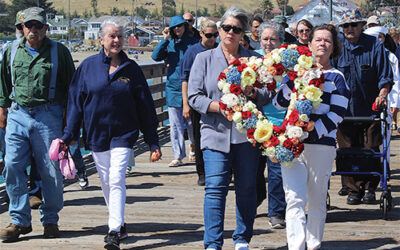The corpse flower blooms at Cal Poly. Photo by Joe Johnston/Cal Poly
Who wouldn’t want a flower that smells like rotting flesh? For the first time ever, a Titan Arum, or corpse flower, bloomed at Cal Poly and folks were invited to see it.
The corpse flower, this one is named Musty, grows from a large underground stem and sends up one leaf a year, which can reach over 10 feet tall. After 10 or more years, instead of making a leaf, the plant sends up a huge maroon funnel, called the spathe, with tiny flowers on a huge spike.
“I’ve wanted to see one of these plants since I heard stories of them in a college botany class,” said Shari Sullivan, an owner of Estero Bay News who viewed the plant the first day it was open to the public. “I had no idea there was one so close by. People are really focused on the smell, but the flower itself is gorgeous – colors ranging from deep purpley-maroons to a bright lime green. And it’s definitely the biggest flower I’ve ever seen.”
Corpse flowers are open for only two days. At its tallest, the bloom holds the record for the world’s largest unbranched cluster of flowers arranged on a stem, called an inflorescence. To attract the insects that pollinate the plant, the spathe acts like a funnel, sending out a foul aroma similar to that of rotting flesh.
Dung beetles, flesh flies and other carnivorous insects are the primary pollinators of this type of flower. These insects typically eat dead flesh. The smell and the dark burgundy color of the corpse flower are meant to imitate a dead animal to attract these insects.
According to the Chicago Botanic Garden’s blog, analyses show that chemically the stench consists of:
• dimethyl trisulfide (also emitted by cooked onions and limburger cheese)
• dimethyl disulfide (which has an odor like garlic)
• trimethylamine (found in rotting fish or ammonia)
• isovaleric acid (which also causes sweaty socks to stink)
• benzyl alcohol (a sweet floral scent found in jasmine and hyacinth)
• phenol (sweet and medicinal, as in Chloraseptic throat spray)
• indole (like mothballs)
Many flower fans waited in long lines to view the plant for the allotted one minute. After taking photographs with Musty, some remarked that the plant wasn’t as pungently pervasive as expected.
They say timing is everything — the putrid smell is most potent during peak bloom at night into the early morning. The plant’s inflorescence also generates heat, which allows the stench to travel further.
“I was a little disappointed to miss the stank,” Sullivan said. “I guess I was a little overexcited and got there too early to really get the full experience. I’ll have to remember that for the next time in, what, 2027?”
Cal Poly horticulture and botany students have been growing the Amorphophallus titanum for several years—and this is the plant’s first flower.
California saw its first Titan Arum bloom in 1999 at the Huntington Botanical Garden in Southern California.
A livestream of the flower can be viewed online at https://www.youtube.com/channel/UCAsVqB6JJJ7V9Azpa6Cp3EQ.



